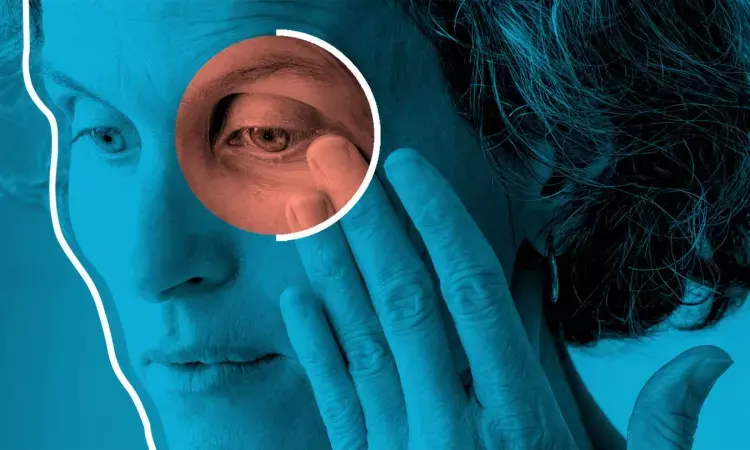- Home
- Medical news & Guidelines
- Anesthesiology
- Cardiology and CTVS
- Critical Care
- Dentistry
- Dermatology
- Diabetes and Endocrinology
- ENT
- Gastroenterology
- Medicine
- Nephrology
- Neurology
- Obstretics-Gynaecology
- Oncology
- Ophthalmology
- Orthopaedics
- Pediatrics-Neonatology
- Psychiatry
- Pulmonology
- Radiology
- Surgery
- Urology
- Laboratory Medicine
- Diet
- Nursing
- Paramedical
- Physiotherapy
- Health news
- Fact Check
- Bone Health Fact Check
- Brain Health Fact Check
- Cancer Related Fact Check
- Child Care Fact Check
- Dental and oral health fact check
- Diabetes and metabolic health fact check
- Diet and Nutrition Fact Check
- Eye and ENT Care Fact Check
- Fitness fact check
- Gut health fact check
- Heart health fact check
- Kidney health fact check
- Medical education fact check
- Men's health fact check
- Respiratory fact check
- Skin and hair care fact check
- Vaccine and Immunization fact check
- Women's health fact check
- AYUSH
- State News
- Andaman and Nicobar Islands
- Andhra Pradesh
- Arunachal Pradesh
- Assam
- Bihar
- Chandigarh
- Chattisgarh
- Dadra and Nagar Haveli
- Daman and Diu
- Delhi
- Goa
- Gujarat
- Haryana
- Himachal Pradesh
- Jammu & Kashmir
- Jharkhand
- Karnataka
- Kerala
- Ladakh
- Lakshadweep
- Madhya Pradesh
- Maharashtra
- Manipur
- Meghalaya
- Mizoram
- Nagaland
- Odisha
- Puducherry
- Punjab
- Rajasthan
- Sikkim
- Tamil Nadu
- Telangana
- Tripura
- Uttar Pradesh
- Uttrakhand
- West Bengal
- Medical Education
- Industry
Squeezing and rubbing of eyelids substantially increases IOP in glaucoma patients: BMJ

Germany: Eyelid maneuvers (especially substantial with squeezing and rubbing) caused transient elevations in intraocular pressure (IOP) in individuals with primary open-angle glaucoma (POAG), says an article published in the British Journal of Ophthalmology.
Patients with glaucoma who are using topical glaucoma medication frequently have dry eye symptoms and are thus more inclined to touch or pinch their eyelids. In this work, Jacqueline J O N van den Bosch and colleagues telemetrically measured peak intraocular pressure (IOP) during eyelid motions and eyelid rubbing.
As a baseline measurement, 11 patients with primary open-angle glaucoma who had previously been implanted with a telemetric IOP sensor (Eyemate-IO) were told to stare straight ahead for 1 minute. Following that, 6 cycles of blinking on command with 10 s intervals were conducted. In addition, 5 rounds of eyelid closure (n=9), squeezing (n=7), and rubbing (n=7) were conducted at 15 s intervals. IOP was measured using an external antenna that was wrapped around the subject's eye. One-sample t-tests were used to compare average peak IOP changes from baseline to zero (no change).
The key findings of this study were as follows:
1. The average peak IOP rise (mean±SEM) from baseline for eyelid rubbing was 59.1±9.6 mm Hg.
2. Eyelid squeezing was 42.2±5.8 mm Hg, eyelid closure was 3.8±0.6 mm Hg, and voluntary blinking was 11.6±2.4 mm Hg.
3. During involuntary blinking, there was no change in IOP except for a brief irregularity in the ocular pulse.
Both eyelids rubbing and squeezing induced IOP rise exceeding 40 mm Hg, voluntary blinking elicited a 12 mm Hg increase and eyelid closing elicited a short spike of 4 mm Hg followed by a persistent reduction. "More research is needed to determine if IOP rise caused by squeezing and rubbing contributes to glaucoma," quoted the PI in conclusion.
Reference:
van den Bosch, J. J. O. N., Pennisi, V., Mansouri, K., Weinreb, R. N., Thieme, H., Hoffmann, M. B., & Choritz, L. (2022). Effect of eyelid muscle action and rubbing on telemetrically obtained intraocular pressure in patients with glaucoma with an IOP sensor implant. In British Journal of Ophthalmology (p. bjophthalmol-2021-320508). BMJ. https://doi.org/10.1136/bjophthalmol-2021-320508
Neuroscience Masters graduate
Jacinthlyn Sylvia, a Neuroscience Master's graduate from Chennai has worked extensively in deciphering the neurobiology of cognition and motor control in aging. She also has spread-out exposure to Neurosurgery from her Bachelor’s. She is currently involved in active Neuro-Oncology research. She is an upcoming neuroscientist with a fiery passion for writing. Her news cover at Medical Dialogues feature recent discoveries and updates from the healthcare and biomedical research fields. She can be reached at editorial@medicaldialogues.in
Dr Kamal Kant Kohli-MBBS, DTCD- a chest specialist with more than 30 years of practice and a flair for writing clinical articles, Dr Kamal Kant Kohli joined Medical Dialogues as a Chief Editor of Medical News. Besides writing articles, as an editor, he proofreads and verifies all the medical content published on Medical Dialogues including those coming from journals, studies,medical conferences,guidelines etc. Email: drkohli@medicaldialogues.in. Contact no. 011-43720751


